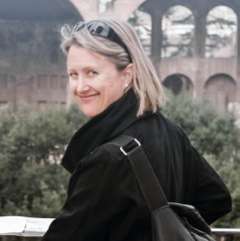We’ve all been dazzled at some point by the impromptu art created in a kaleidoscope, its loose, colorful bits between plate and mirror reflected and reconfigured into appealing patterns. Artful patterns come to life in San Francisco Ballet’s Program 2, Kaleidoscope, which opened last Tuesday night at the War Memorial Opera House.
The master of reconfiguring patterns in dance was George Balanchine, and his 1956 Divertimento No. 15, set to Mozart’s music by the same name, opened the program, the females in pale blue and yellow Karinska-inspired pancake tutus, the men in classic tunics and tights. This is a ballet of pleasing proportions, of clever intricacies illuminated, much like Mozart’s chamber composition. Balanchine utilized sixteen dancers: an eight-member corps ensemble, and in lead roles, five females to three males. The imbalance of number enhances the kaleidoscopic perspective, such as when Sasha De Sola, placed between Mathilde Froustey and Isabella DeVivo, turns to face first one dancer while moving, and then the other. The formation is whimsical, unexpected.
Lonnie Weeks, Angelo Greco and Benjamin Freemantle charmed with alternating entrechat jumps, each one landing in pirouette prep and spinning as the next dancer took off. Freemantle, in particular, looked so buoyant, his footwork so clean and articulated, the joyous expression on his face belying the challenge of a sky-bound entrechat-huit. The ballet afforded frequent opportunities for the dancers to have their solo movement and shine. Lonnie Weeks’s tricky brisés, Julia Rowe’s witty arm movements, Koto Ishihara’s purposely tilted arabesque, were but a few. Mathilde Froustey, lithe and musical, injected a touch of mischievous charm in her smile in a way Mozart would have loved. One movement's close brought a beautiful courtly bow, a throwback to a more regal, chivalrous time. Mark Stanley’s lighting and Martin West with the San Francisco Ballet Orchestra provided further refinement to a ballet crystalline in its appeal and execution.
Constantly shifting patterns and groupings also featured in Justin Peck’s Hurry Up, We’re Dreaming. The ballet had its world premiere here at the 2018 Unbound Festival, his second commission for the company. Peck, 31 and resident choreographer for the New York City Ballet, sought to explore through dance how we dream as children, as young coming-of-age adults, as fully matured ones. It did indeed feel like a young person’s exploration, of dreams or otherwise, but maintained a young person’s dynamic throughout, aided by the music, electronic pop by the group M83. It’s the kind of music you either like or you don’t. Which can apply to the ballet as well: the ultra-hip, aerobic nature of it, dancers clad in sneakers, the propulsive speed, the ballet’s urban feel, won’t be for everyone. Fortunately, the San Francisco Ballet dancers, always keen for a challenge, take the work and run with it (literally). Notable were Dores André and Joseph Walsh, the latter a welcome sight after a season off due to injury. Alongside Walsh’s strong technique and his natural skill for this kind of fare, he had a devilish grin and contagious enthusiasm. Elizabeth Powell shared a particularly affecting pas de deux with Luke Ingham, bringing to the ballet a sense of greater depth and soul. A ponytailed Gabriela Gonzalez had a delightful insouciant swagger as she paired up with Ulrik Birkkjaer, who was having a great night in not one but two of the ballets. (The same kudos for double duty goes out to André, Powell, De Sola and Freemantle.) The iridescence of costumes designed by Reid Bartelme and Harriet Jung seemed washed out in James F. Ingalls’ dark lighting, but surprisingly effective was the spare, open stage, devoid of backdrop and deep wings.
Benjamin Millepied’s Appassionata, sandwiched between the evening’s other ballets, delivered a more sensuous take on the kaleidoscope motif, highlighting the dynamics to be found in interpersonal relationships. Created in 2016 during his directorship of Paris Opéra Ballet (then titled La Nuit S’Achève), it’s set to Beethoven’s Piano Sonata No. 23 in F minor, the "Appassionata,” beautifully rendered on Tuesday night by pianist Mungunchimeg Buriad. Featuring six dancers, the ballet explores personal relationships between couples, with an occasional partner swap. Camille Dugas’s scenic design and Jim French’s lighting conjured a thoughtful, brooding mood. The dancers’ attire, in Alessandro Sartori’s red, blue and purple colors, evolved into scantier fare: flowing shifts of white, grey and black, and later, unbound hair for the women. A pas de deux with Ulrik Birkkjaer and Dores André was stunning, utilizing stillness as effectively as the tumultuous partnered movements that followed. All the dancers, which included Sasha de Sola and Benjamin Freemantle, Jaime Garcia Castilla and Elizabeth Powell, shone in a final, impassioned flurry of dancing, alongside Beethoven’s equally impassioned opus.


